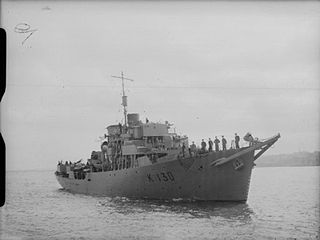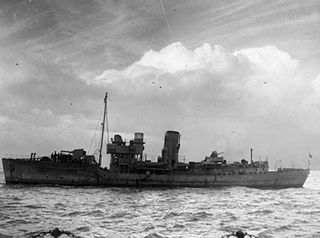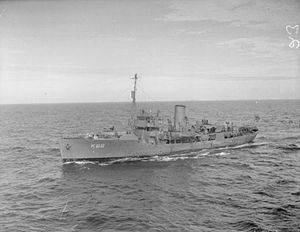
HMCS Snowberry was a Flower-class corvette that was originally built for the Royal Navy, but spent most of the war in service with the Royal Canadian Navy. She fought primarily as a convoy escort during the Second World War. She served primarily in the Battle of the Atlantic.

HMS Arbutus was a Flower-class corvette of the Royal Navy, which was active during the Second World War. She was a successful escort vessel, and took part in the destruction of two U-boats during the Battle of the Atlantic. Arbutus was sunk in the North Atlantic in February 1942.

HMCS Moose Jaw was a Royal Canadian Navy Flower-class corvette which took part in convoy escort duties during the Second World War. Together with HMCS Chambly, she achieved the RCN's first U-boat kill of the war. She was named after Moose Jaw, Saskatchewan.

HMS Lotus was a Flower-class corvette that served in the Royal Navy.
HMS Heartsease was a Flower-class corvette of the Royal Navy. She served with both the Royal Navy and the United States Navy during the Second World War, with the latter navy as USS Courage. She then spent several years under a succession of names in civilian service. In 1957 she was chartered on behalf of Indonesian rebels to smuggle rubber, copra and matériel. The Indonesian Air Force intercepted and sank her off the coast of Minahasa in North Sulawesi in December 1958.

USS Surprise (PG-63), the fourth American naval ship of the name, was a Temptress-class patrol gunboat during World War II. She was built as the British Flower-class corvette HMS Heliotrope, and was in service with the Royal Navy during the first years of the Battle of the Atlantic. She was loaned to and operated by the United States Navy from 1942–1945. After World War II, she was sold as a merchant vessel and ended her life in the Chinese navy as Lin I.
HMS Arabis was a Flower-class corvette of the Royal Navy. The ship was commissioned into the Royal Navy as HMS Arabis. She was transferred to the United States Navy in 1942, serving as USS Saucy. Returned to the United Kingdom in 1945, she was recommissioned into the Royal Navy as HMS Snapdragon.

HMCS Rosthern was a Flower-class corvette that served in the Royal Canadian Navy during the Second World War. She served primarily in the Battle of the Atlantic as a convoy escort. She is named for Rosthern, Saskatchewan.

HMCS Fredericton was a Flower-class corvette of the Royal Canadian Navy. She was ordered from Marine Industries Ltd. in Sorel, Quebec and laid down on 22 March 1941. She was launched on 2 September 1941 and commissioned on 8 December 1941. She was named after the community of Fredericton, New Brunswick.
HMS Veronica was a Flower-class corvette, built for the Royal Navy during the Second World War, and was in service in the Battle of the Atlantic. In 1942 she was transferred to the United States Navy as part of the reverse Lend Lease arrangement and renamed USS Temptress, the name ship of the Temptress-class gunboats. With the end of hostilities she was returned to the Royal Navy and sold into mercantile service.
HMS Calendula was a Flower-class corvette, built for the Royal Navy during the Second World War, and was in service in the Battle of the Atlantic. In 1942 she was transferred to the United States Navy as part of the reverse Lend Lease arrangement and renamed USS Ready, one of the Temptress-class gunboats. With the end of hostilities she was returned to the Royal Navy and sold into mercantile service.
HMS Candytuft was a Flower-class corvette, built for the Royal Navy during the Second World War, and was in service in the Battle of the Atlantic. In 1942 she was transferred to the United States Navy as part of the reverse Lend Lease arrangement and renamed USS Tenacity, one of the Temptress-class gunboats. With the end of hostilities she was returned to the Royal Navy and sold into merchantile service.
HMS Oxlip was a Flower-class corvette that served in the Royal Navy during World War II.

HMS Rhododendron was a Flower-class corvette that served with the Royal Navy during the Second World War. She served as an ocean escort in the Battle of the Atlantic.

HMS Dianella was a Flower-class corvette of the Royal Navy. She served during the Second World War.

HMS Lagan (K259) was a River-class frigate of the Royal Navy (RN). Lagan was built to the RN's specifications as a Group II River-class frigate. She served in the North Atlantic during World War II.

HMS Hibiscus was a Flower-class corvette, built for the Royal Navy during the Second World War, and was in service in the Battle of the Atlantic. In 1942 she was transferred to the United States Navy as part of the Reverse Lend-Lease arrangement and renamed USS Spry, one of the Temptress-class gunboats. With the end of hostilities she was returned to the Royal Navy and sold into mercantile service.

HMS Periwinkle was a Flower-class corvette, built for the Royal Navy during the Second World War, and was in service in the Battle of the Atlantic. In 1942 she was transferred to the United States Navy as part of the Reverse Lend-Lease arrangement and renamed USS Restless, one of the Temptress-class gunboats. With the end of hostilities she was returned to the Royal Navy and sold into mercantile service.

HMS Larkspur was a Flower-class corvette, built for the Royal Navy during the Second World War, and was in service in the Battle of the Atlantic. In 1942 she was transferred to the United States Navy as part of the Reverse Lend-Lease arrangement and renamed USS Fury, one of the Temptress-class gunboats. With the end of hostilities she was returned to the Royal Navy and sold into mercantile service.
HMS Pink was a Flower-class corvette that served in the Royal Navy. She was built by Henry Robb in Leith in 1941 and named after the flower nicknamed garden pink. She was commissioned in 1942 and scrapped in 1947.













